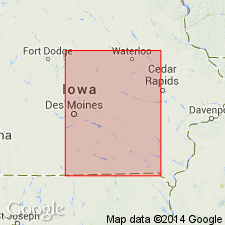
- Usage in publication:
-
- Stephens Forest Formation
- Modifications:
-
- Named
- Dominant lithology:
-
- Shale
- Limestone
- AAPG geologic province:
-
- Iowa shelf
Summary:
Named as a formation (1 of 11) of the Marmaton Group of the Des Moines Supergroup. Name derived from Stephens State Forest, a tract of land south of town of Lucas. Type locality is at NW1/4, sec 18, T72N, R22W, Lucas Co, IA on the Iowa shelf where it overlies the Morgan School Shale (new) of the Marmaton and underlies the Labette Shale of the Marmaton. Divided into the 1) Little Osage Shale Member, at base (restricted in this report to rocks above the Summit Coal, a name formally designated here as the upper member of the Morgan School Shale) and beneath the Houx Limestone Member), 2) Houx, Limestone Member (formerly a member of Little Osage Formation), 3) unnamed shale Member, and 4) Higginsville Limestone Member (extended into IA). Consists, at type, of black to gray, silty shale with phosphate lenses (Little Osage) 2.5 ft thick, brown, laminated, calcareous shale with brachiopods 1.6 ft thick, gray, silty, calcareous shale with sparse brachiopods, calcareous nodules 7.0 ft thick, and gray, fine grained, dense limestone with brachiopods and crinoids (Higginsville) 0.4 ft thick. Nomenclature chart. Graphic sections of Pennsylvanian, Desmoinesian age.
Source: GNU records (USGS DDS-6; Denver GNULEX).
For more information, please contact Nancy Stamm, Geologic Names Committee Secretary.
Asterisk (*) indicates published by U.S. Geological Survey authors.
"No current usage" (†) implies that a name has been abandoned or has fallen into disuse. Former usage and, if known, replacement name given in parentheses ( ).
Slash (/) indicates name conflicts with nomenclatural guidelines (CSN, 1933; ACSN, 1961, 1970; NACSN, 1983, 2005, 2021). May be explained within brackets ([ ]).

